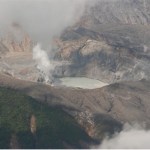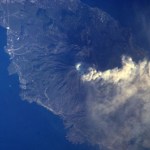Sakurajima
Finally, a chance to catch up a bit ... !
Yasur erupting in May of 2010.
Some news from the world of volcanoes:
The BBC has a series of videos one the fallout from the Eyjafjallajökull eruption - including a look at the area around the volcano and how the economy has been affected by the eruption. However, things seem pretty quiet at the summit of the Eyjafjallajökull summit where snow can begun to settle without melting - and the Icelandic Met Office appears to think that the eruption is more or less (but not officially) over. And take this press release as you will, but a recent study…
News!
The summit crater lake at Gorely in Russia, taken on June 21, 2010. Image courtesy of KVERT.
Eruptions readers have been abuzz about how KVERT will be closing shop (yet again) at the end of June. This would, of course, leave no local monitoring and expertise in the very active Kamchatka Peninsula and Kuril Islands in Russia. Right now Shiveluch and Gorely are both showing signs of increased eruption (along with other volcanoes in the arc). In fact, Gorely, which hasn't erupted since 1986, looks primed to have an eruption, with increased tremors, steam-and-gas emissions and a new…
Sakurajima in Japan erupting in 2000.
Sometimes, it is the volcanoes that erupt out of the blue that get all the attention, leaving the ones that are constant producers to be ignored by the fawning media. Sakurajima in Japan is just one of those constant erupting volcanoes that doesn't get its just due. Well, over the weekend, Sakurajima broke its own record as it produced its 549th explosive event this year - in June no less - marking the most explosions (video) in a single year at the volcano on record. The previous record for most explosive eruptions in a single year at Sakurajima was 548…
Have guests in town, so I'm a little busy, but you can hopefully keep entertained with the latest Smithsonian/USGS Global Volcanism Program Volcanic Activity Report.
Chile's Melimoyu volcano.
The highlights (not including Taal and Eyjafjallajökull) include:
Alaska's Cleveland volcano has been reduced to and alert status of "unassigned" (used when a volcano is not closely monitored so AVO doesn't know what exactly is "background") after a few weeks of activity. The same was done for the submarine volcano south of Sarigan in the Marianas Islands after no signs of activity since the eruption…
Some news for a busy Tuesday:
The crater at Poas volcano in Costa Rica, taken February 25, 2010. Image courtesy of OVSICORI by Federico Chavarria.
After the MSNBC debacle, it is nice to see some good articles on why the Chilean earthquake was overall less disastrous than the Haitian earthquake, why the tsunami wasn't as large as predicted and why these earthquakes are not abnormal. There are a lot of factors involved - the location, depth, preparedness, wealth - so the comparison can be very telling in terms of both geologic and societal issues.
The other scientific fallout from the Chilean…
Sakurajima Volcano in Japan, taken from the ISS on February 17. Image courtesy of Soichi Noguchi.
Eruptions reader Tim Stone sent me a link to the TwitPic feed for Soichi Noguchi, the Japanese astronaut currently on board of the International Space Station. The space traveller got a shot of Sakurajima from space, showing a beautiful plume drifting off - and great detail of the towns and roads near the volcano. Soichi has some other great shots (and comments to go with them), including my old haunt Seattle (with a comment about Ichiro), Mt. Aso - another Japanese volcano, and the Patagonian…
Sally Sennert from the Smithsonian Institution sent me an email to say that this week's USGS/Smithsonian Institute Weekly Volcanic Report will be delayed due to the inclement weather in the Washington DC area. She can't connect with the server, so the report can't be updated on the Smithsonian website ... so here it is! Look for it to show up on the Smithsonian site with all the bells and whistles as soon as DC thaws out.
And a big thanks to Sally for sending me the Report to post.
***PLEASE NOTE: Website posting of the SI/USGS Weekly Volcanic Activity Report for 3-9 February 2010 will be…
News for the snowy (well, here) midweek:
Lava flows from Kilauea surround an old structure at Royal Gardens in Hawai`i.
A hearty thanks to all the Eruptions readers who offered advice on where to find a couple of great volcano videos I've been trying to track down. I think I've found copies I can get a hold of at the USGS and discovered that Discover Your Northwest (formerly the NW Interpretative Assoc.) is expecting to get a DVD version of one of the videos this spring.
The folks at the Astronomy Picture of the Day put up this great image of strombolian eruptions and lightning at…
Sakurajima in Japan, erupting in December 2009. Image courtesy of Photovolcanica.com
Richard Roscoe at Photovolcanica.com has just posted two great sites focusing on two of the most active volcanoes in Japan: Sakurajima and Suwanosejima. These volcanoes are almost constantly erupting with small strombolian events punctuated by occasional plinian eruptions.
Sakurajima is on the island of Kyushu (well, technically Kagoshima, but right off the coast of Kyushu) less than 10 miles / 20 km from the city of Kagoshima. The volcano has been erupting since 1955 with both explosive and effusive…
All the news to start the week:
Galeras with a grey ash-and-steam plume behind Pasto, Colombia.
Well, after my article on Friday about Colombian volcanoes, Galeras must have decided it was left out. The volcano has been placed back at alert level Orange/II (eruption in days to weeks). An increase in seismicity and sulfur dioxide emissions (in spanish) prompted INGEOMINAS to put Galeras back on higher alert, but now the country has two volcanoes (Galeras and Huila) that could be erupting in the near future.
Back in the Philippines, there is new evidence that Mayon has a new dome forming at…
Somehow I missed a week of the SI/USGS Weekly Volcano Activity Reports and almost missed another. Here is this week's update!
Highlights (not including Chaiten, Soufriere Hills or Cleveland) include:
The alert level at Galeras in Colombia was raised to Red after an explosion on September 30 and returned to orange ... and then yellow ... after activity tapered.
Sakurajima in Japan produced 1.8-4.3 km / 6,000-14,000-tall ash-and-steam plumes, along with incandescent tephra that was thrown almost two kilometers from the vent.
Multiple steam-and-ash plumes reached 4.3 km / 14,000 feet at Langila…
Even the SI/USGS Weekly Volcano Report seems a little light -- welcome to the dog days of summer!
Highlights from this week's report include:
"Thunderous sounds", incandescence and small plumes (hundreds of meters) with more frequent seismicity at Ibu in Indonesia.
A sharp increase in sulfur dioxide output was noted at Mayon in the Philippines on August 4 - from ~700-900 tonnes/day to almost 2,000 tonnes/day.
~3,000 meter/10,000 foot gas-and-ash plume from Bagana in Papua New Guinea - you can see it on this recent NASA Earth Observatory image.
Ash/gas plumes from Sakurajima in Japan rose to…
Your volcano news!
Thanks, as always, to the USGS/SI Global Volcanism Program.
Highlights include:
The alert level at Sakurajima was raised from 2 to 3 by the Japanese Meteorological Agency. This was due to the increasing frequency of explosions at the volcano, some of which produced ash plumes up to 1.8-2.7 km / 6-9,000 feet.
Ash was reported up to 3 km away from Ibu in Indonesia. However, officials in Indonesia lowered the alert from 3 to 2, but tourists are still restricted from going with 2 km of the volcano.
Lots of activity at Shiveluch in Kamchatka. You can see some of the activity in…
Here's the latest news from the USGS and SI Global Volcanism Program. It might not record every little volcanic noise in the world each week, but nothing like getting all the major volcanic events summarized on a weekly basis.
Highlights this week (not including Nyiragongo, Redoubt and Galeras):
The eruption at Rinjani in Indonesia continues, with elevated seismicity and 300-600 meter plumes.
Sporadic strombolian eruptions from the Crater C at Arenal, Costa Rica (since late April)
High seismicity, 100 meter domes and continued dome collapses continue at the two domes growing at Chaiten,…
Here's the latest Global Volcanism Program activity report for worldwide volcanism. Some of the highlights (beyond Fernandina and Llaima) include:
Vulcanian-style eruptions at Sakurajima, Japan. And guess what? There is a Sukarajima webcam! {Hat tip to Eruptions reader Jodie Morris for this link}.
Strombolian-style explosions and avalanches associated with lava flows at Arenal, Costa Rica.
A 10,000 foot / 3,000 meter ash plume from Dukono in Indonesia.
Satellite imagery exposed a thermal anomaly in the dome at Shiveluch on the Kamchatka Peninsula.
Your weekly dose of volcanic activity. As a sidenote, you can now get placemarks for the weekly activity report via Google Earth. Select "Google Earth Placemarks" from the SI / USGS Weekly Volcanic Activity Report page.
Highlights of this week's report:
New explosions at Ebeko. See my article today for more details.
More evidence of increased activity at Nyamuragira and Nyiragongo, Congo. One interesting note is that scientists from the Goma Volcano Observatory noted that earthquake swarms usually precede eruption by 3-5 months.
I've seen very little news about this, but Pacaya in Guatemala…
Ulawun Volcano, Papau New Guinea, one of the "Decade Volcanoes"
There was some discussion earlier about the so-called "Decade Volcanoes", so I thought I'd elaborate a bit on them (doubly so in light of certain other lists.) These volcanoes are defined by IAVCEI - the International Association of Volcanology and the Chemistry of the Earth's Interior - and are part of a program whose aim is
"to direct attention to a small number of selected, active volcanoes world-wide and to encourage the establishment of a range of research and public-awareness activities aimed at enhancing an…
I am back from the ion microprobe lab at Stanford after a few days of data collection, so I'll be trying to get back on posting schedule here at Eruptions.
UPDATE 3/10/2009 12:45PM: Here is a little (and I mean a little) more information, mostly adding that the local residents have been given a "warning" about the activity.
However, I did notice this morning at Sakurajima in Japan erupted after rumbling over the weekend. There aren't many details about the eruption beyond the fact that volcanic chunks were thrown a few kilometers from the vent, but the BBC does have some nice video of the…
Mt. Asama near Tokyo did, in fact, erupt within the "two day" window predicted by the Meteorological Agency of Japan. The reports this morning put the ash column at ~2,000 meters (~6-7,000 feet), so relatively small, but big enough to dust parts of Tokyo (~145 km away) with ash. No evacuations are planned for the area around Asama, but people who live within 4 km of the volcano are to "take caution".Â
There are also new reports that Mt. Sakurajima in southern Japan erupted yesterday. Block were thrown up to a few kilometers from the volcano. The article suggests that ash spread as far…

